- The Indonesian government plans to build or upgrade thousands of kilometers of roads in Kalimantan, the Indonesian portion of Borneo Island.
- Proponents of the project say infrastructure upgrades are necessary to support a growing population, will boost economic growth, and will provide better access to services.
- But conservationists are concerned these roads will fragment and degrade some of the island’s last remaining intact ecosystems.
- This summer, Mongabay traveled the length of one such project in East Kalimantan province, into a remote region already undergoing changes as a result of current and planned road upgrades.
SAMARINDA/UJOH BILANG, Indonesia — For nearly a week this summer, the residents of Ujoh Bilang in Indonesian Borneo’s East Kalimantan province were virtually disconnected from the rest of the world. Situated in the upper reaches of the Mahakam River, or Mahakam, the villagers rely on the river for transport downstream to the larger towns and the provincial capital, Samarinda. When days of torrential rain sent the river over its banks, that vital lifeline was cut.
Unable to transport people or goods by river, authorities in Samarinda eventually had to deliver aid via the only existing road. Ujoh Bilang is less than 250 kilometers (155 miles) from Samarinda as the crow flies, but the trip along the largely unpaved, patchy and potholed road is an arduous trek over 700 kilometers (435 miles), through montane forests and across three districts. It requires at least a day by four-wheel-drive vehicle — and significantly longer if the road is wet.
This difficulty in delivering aid, and the resulting vulnerability in the face of natural disasters, is one of many examples that people here in the Mahakam Ulu region cite when demanding better road infrastructure. And since the region was designated as a new administrative district in 2013, and three years later elected its first local government, road projects worth millions of dollars have become the highest priority.
The district’s road development plan, however, has sparked environmental and social concerns.


Mahakam Ulu has a large population of indigenous communities and a natural landscape with rich biodiversity. It is home to critically endangered species such as the Sumatran rhino, the Bornean orangutan, and the helmeted hornbill, and is important for the sustainability of the rest of East Kalimantan. Mahakam Ulu is also part of the Heart of Borneo conservation initiative, which seeks to protect 220,000 square kilometers (85,000 square miles) of tropical rainforest across Malaysia, Indonesia and Brunei that have been designated as particularly important for the preservation of the island’s ecosystems and biodiversity.
That biodiversity, and the human cultures that depend on it, are already facing multiple threats. Industrial-scale forest clearing for mining, logging, and oil palm cultivation have resulted in the loss of 31 percent of Indonesian Borneo’s rainforests between 1973 and 2014. In 2015 alone, another 3,230 square kilometers (1,247 square miles) of forest was lost in Kalimantan, nearly half of the total deforestation recorded in Indonesia that year. The extensive draining of the island’s peat forests to make way for agriculture has also rendered the soil highly susceptible to burning.
The current population of Kalimantan is around 16 million, estimated to increase by nearly a third to more than 20 million by 2035. President Joko Widodo also recently announced plans to relocate Indonesia’s capital to East Kalimantan from Jakarta. It seems inevitable that this rapidly expanding population will demand services and infrastructure across East Kalimantan.
But large-scale road projects across the country have been linked to further fragmentation of prime forests and increased tensions between indigenous communities and the people moving into newly developed areas. Road projects in Indonesian villages are also typically riddled with corruption. And conservationists and indigenous activists fear the same could happen in Mahakam Ulu.
“I am not against this infrastructure development. I think it will be very helpful for all kinds of underprivileged people,” Margaretha Seting Beraan, the head of the East Kalimantan chapter of the Indigenous Peoples Alliance of the Archipelago (AMAN), told Mongabay. “But we must take into account the subsequent negative impacts [from road development projects] and resolve as many of them as possible.”

In July, Mongabay traveled to Mahakam Ulu from Samarinda through the same road used by authorities to deliver aid earlier in the summer. The trip took two days, with the terrain becoming rougher the closer we got. The road remains so rough that drivers of four-wheel-drive vehicles frequently refuse to make the trip without a second vehicle along to provide a tow in case of mishaps. On our trip, we had to stop and help the occupants of another car that was stuck in a muddy pothole.
But where the road is paved, changes are already visible. Land clearing for houses has taken place. Some of the residents have moved closer to the road. Oil palm plantations run neatly alongside the road as it slices through forests that had previously been logged. This is just one of many road projects that are designed to improve connectivity for remote areas in Indonesian Borneo, but it serves as a microcosm of the possibilities and perils of such projects.

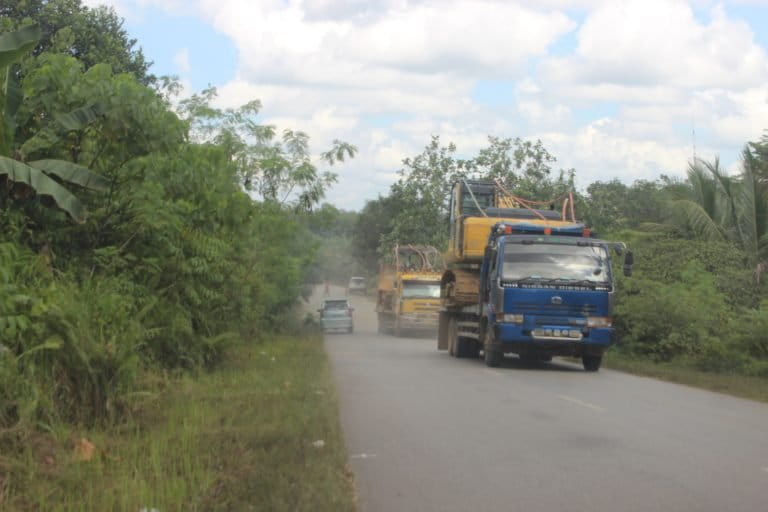

A ‘stepchild’ district
Home to a little more than 28,500 people, Mahakam Ulu spans some 15,300 square kilometers (5,900 square miles), three times the size of the Grand Canyon, on Indonesia’s borders with the Malaysian state of Sarawak. In 2013, the district was officially established after it was partitioned from West Kutai, and Ujoh Bilang was designated as its capital.
The call to separate Mahakam Ulu from the greater West Kutai district was driven largely by demands from locals who felt neglected by the administration in West Kutai, particularly when it came to infrastructure and the economy.
“We felt like we were a stepchild,” says 45-year-old Idawati, who was born and raised in Mahakam Ulu.
Mahakam Ulu’s lack of connectivity to the rest of East Kalimantan and its reliance on river transport increases the cost of living for locals, especially when the Mahakam River floods or when it recedes significantly during long dry periods.A 25-kilogram (55-pound) bag of rice can sell here for 500,000 rupiah ($35), twice as expensive as in the provincial capital; it can cost even more in the most remote upstream villages. Meanwhile, the monthly minimum wage in East Kalimantan stands at just 2.75 million rupiah ($193).
“I once had to sell some of the rice that I had set aside for personal consumption,” says Idawati, who owns a small grocery store in Ujoh Bilang, recalling one of her experiences during a long dry season, when it was impossible to deliver goods by river.
“The road was in a pretty horrible shape that not many people dared to pass it,” Idawati says. “The cost to fix the car might eventually be more expensive than the cost to deliver the goods.”
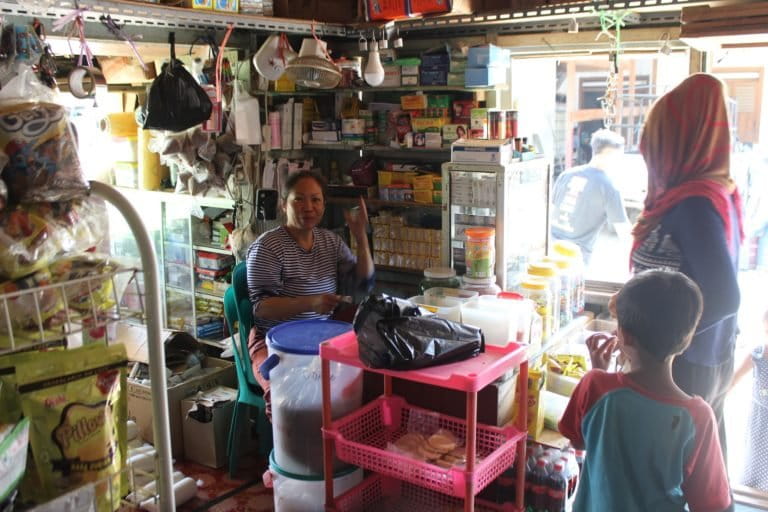

Upgraded to its own district, Mahakam Ulu now has greater autonomy and more funds to develop infrastructure projects, particularly roads.
“When the road access is improved, it will really help us,” Idawati says. “Staple foods will be significantly cheaper. We don’t have to shop in bulk anymore and we won’t need to hire other people to deliver them here because we’ll be able to drive ourselves.”
In 2016, the district elected its first administration to office and road projects made it on top of their list. (From 2013 to 2015, Mahakam Ulu couldn’t build anything as it was still transitioning into a district and its regional budget was controlled by West Kutai district.) The district office is seeking to build a total of 473 kilometers (294 miles) of road by 2021.

Laying the roads
Ongoing road projects in Mahakam Ulu include a 145-kilometer (90-mile) stretch that connects to West Kutai, under construction since 2017. This road project is particularly high priority as it’s expected to ease access to economic centers in East Kalimantan, such as Samarinda and Balikpapan, the biggest city in East Kalimantan and home to the province’s main port.
In September 2018, construction company PT Prampus Inti Puspita was awarded a 38 billion rupiah ($2.7 million) contract to pave 3 kilometers (1.9 miles) of the inter-district road. This would be the first paved road in Mahakam Ulu.
Earlier this year, the deputy district head of Mahakam Ulu, Y. Juan Jenau, said the district had been allocated 121 billion rupiah ($8.5 million) out of the East Kalimantan provincial budget through 2021 specifically for road infrastructure to connect Mahakam Ulu and West Kutai.
In May 2019, the East Kalimantan government said it would develop roads and bridges in areas between Ujoh Bilang and the villages along the Malaysian border. Due to the rough terrain, the government said it would involve the military, as they have the necessary equipment and expertise. “The military needs to open the road access, they will have to go through forests and pass muddy roads,” the provincial government said in a statement.
Local officials tout these road-building projects as a surefire path to economic development.
“When the development of roads and bridges is already finished, the development of other sectors such as agriculture, plantations, and other priority programs will easily follow,” said Mahakam Ulu district head Bonifasius Belawan Geh in March 2018.
“If we keep boosting agriculture, plantations and other economic development, without the support of road and bridge infrastructure, then it would be difficult to sell the products outside,” he added.
Juan said the road development projects in Mahakam Ulu were also part of the Trans-Kalimantan Highway project, a large-scale road network across Indonesian Borneo aimed at boosting economic growth.
“For example, plantation products [from Mahakam Ulu] can be sold to neighboring countries by using the Trans-Kalimantan highway,” he said.

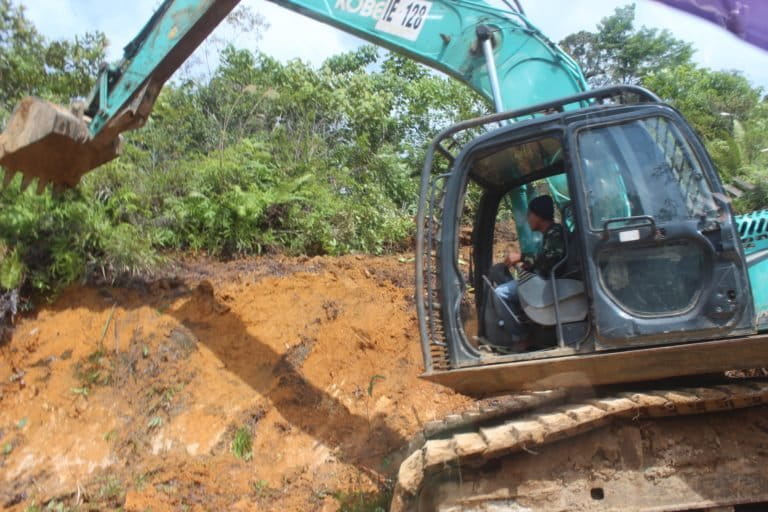
Costly road development
While observers agree that road infrastructure is important for the development of Mahakam Ulu and its residents, they also flag the social and environmental costs of the projects.
“Mahakam Ulu district is in the headwaters of the Mahakam River,” says Ahmad Wijaya, a senior researcher at the Samarinda-based environmental group Bioma Foundation. “It’s the buffer zone for riverine villages and areas — if it’s damaged, then the regions in the downstream, including Samarinda, will be destroyed.”
Conservationists say they also fear that the roads will eventually benefit extractive industries, such as palm oil and mining, more than the locals.
For their part, officials from Mahakam Ulu agree that roads are a key factor in attracting investment into the district. “When we promote the district to investors, they always ask about roads: How’s the access?” Kurnia, head of the permit services department at the Mahakam Ulu investment board, told Mongabay in Ujoh Bilang.
Kurnia said gold miners had expressed interest in entering Mahakam Ulu. “I’m not even sure if there’s a lot of gold in here,” she said. Mongabay observed artisanal gold mining activity along the existing road. Idawati, the store owner, says she used to look for gold before switching jobs.
While industrial mining has yet to reach Mahakam Ulu (it’s one of just three districts in East Kalimantan not yet producing coal) the marks of the oil palm industry were clearly visible as Mongabay traveled on the road that connects Mahakam Ulu to West Kutai. Despite the mountainous terrain, oil palm plantations and nurseries stand tall among the secondary forests.
As of 2018, the district was home to a total 218.6 square kilometers (84.4 square miles) of oil palm plantations owned by 14 companies. According to Kurnia, these concessions were allocated when the district was still part of West Kutai.
Kurnia says many plantations in the district have connections to the Fangiono family, one of Indonesia’s wealthiest.
“They have five companies here. They may not admit these companies are part of the group, but we all know it,” Kurnia says. “It’s always the same person who comes here to handle the papers [for the companies].”
The family’s majority-owned palm oil firm, Singapore-listed First Resources, has one of the largest land banks of any oil palm grower operating in Indonesian Borneo. Its subsidiaries are also embroiled in a number of conflicts with local communities and have been singled out for clearing high conservation value forests. One of Indonesia’s highest-profile land disputes involves a fight over territory between a pair of indigenous communities in East Kalimantan and a First Resources subsidiary called Borneo Surya Mining Jaya (BSMJ).
Heavy trucks loaded with oil palm fruit and crude palm oil ply the public roads. Mongabay observed them passing on the roads between Mahakam Ulu, Kutai Barat, Kutai Kartanegara and Samarinda. Other road users blame the heavy truck traffic for the potholes that pepper the roads and the accidents caused by slippery roads covered in spilled palm oil.
A palm oil mill owned by a subsidiary of the Fangiono Agro Plantations Group was recently built in Mamahak Besar, a subdistrict of Mahakam Ulu.
“When this new mill is fully operational, there’s a big possibility for the expansion of the oil palm plantations,” Bioma’s Ahmad says.
The oil palm companies still largely use the river to transport the fruits to mills, which would make them among the biggest beneficiaries from the road upgrade, Ahmad says. “The fruits must be immediately processed at the mills,” he says. “If the river level recedes and boats can’t operate, then they will need to transport them by road.”

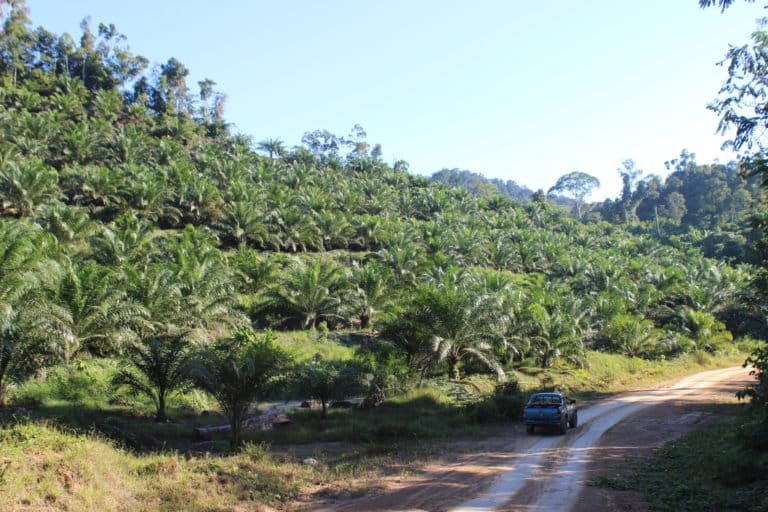
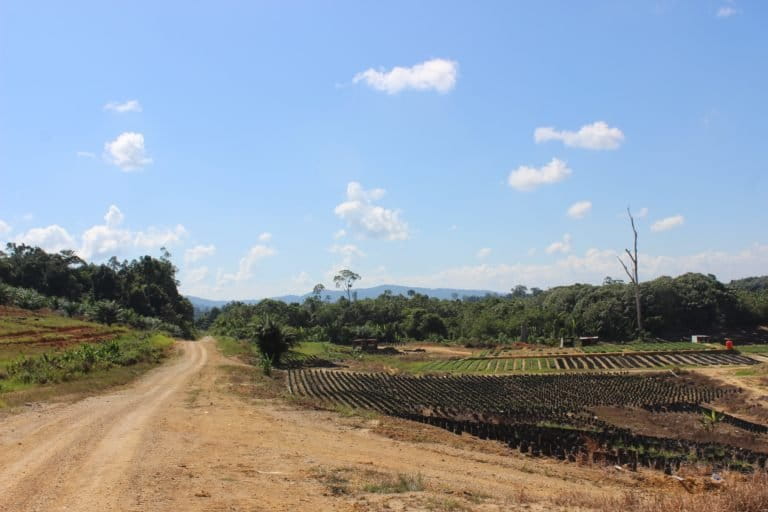

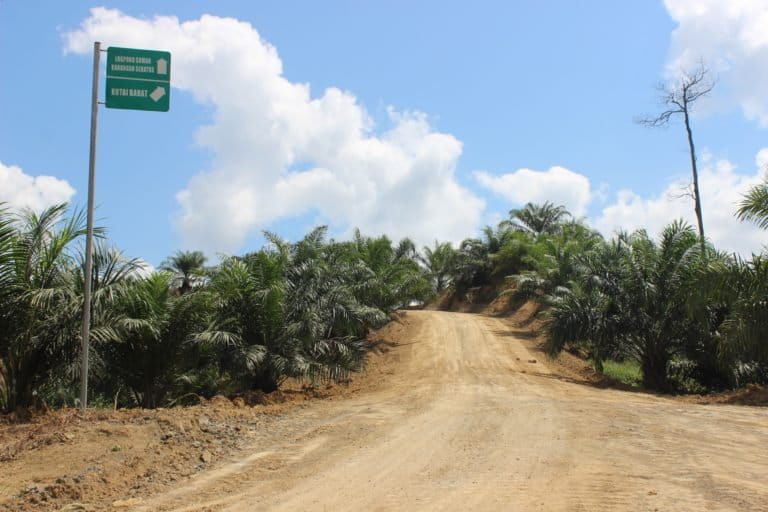
Structural change
Mahakam Ulu is also home to indigenous communities that have for generations lived near the Mahakam River and whose livelihoods depend on the forests. Observers say the development of large-scale road projects in the district would change the social and anthropological dynamics of these communities.
“The riverine villages will relocate to areas on the sides of the road,” says Seting from the indigenous alliance AMAN. “That’s exactly what had happened in West Kutai and Samarinda. Their assets become old, empty villages.”
In Long Melaham village, residents have relocated to the paved road there, where the local government plans to build most of its offices. This anthropological shift, Seting says, is a result of the road development.
“They will also become urban people who are dependent on the economic system,” she says. “They have been such independent communities. It doesn’t matter if the stock market is going up or down. They’re not bothered with that.”
With land in high demand for houses and businesses, there’s a growing risk that overlapping ownership claims might spark conflicts among the people, Seting says. “Land speculation will be rife; people claiming that their elders used to live in the land without solid proof,” she says.
>Land clearing on the sides of the West Kutai-Mahakam Ulu road is also clearly visible. Mongabay saw land that appeared to be recently burned in Data Bilang, another subdistrict. Nearby, seeds of cacao, cempedak (a native Southeast Asian fruit related to jackfruit) and durian stood waiting to be planted. Mongabay also saw logging activities by locals on the sides of the road.
In Long Melaham, where much of the road is already paved, locals are clearing land and building houses. Idawati, the store owner, says she owns one of the houses there. “I built the house because it is on the sideline of the road, and I happened to have the money,” she says.
With improved road infrastructure and an influx of industrial interests, Seting says the people in Mahakam Ulu must be prepared to face the impacts of transmigration.
“The competitiveness of locals will definitely lose against outsiders,” she says, explaining that industries tend to hire workers from regions in Indonesia with a better education system for positions that require more skills, while leaving the blue-collar work for locals.
“They [locals] will start to depend on outsiders. And when that happens, it will become easy to make people become poor — a structural poverty,” Seting says.


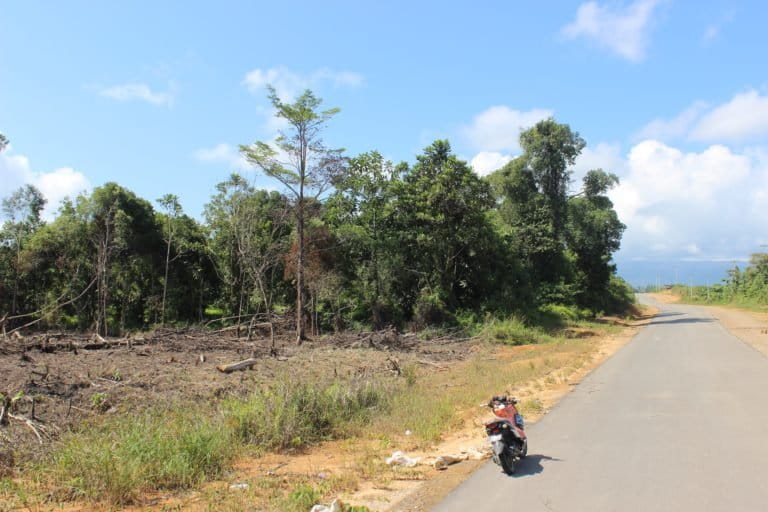


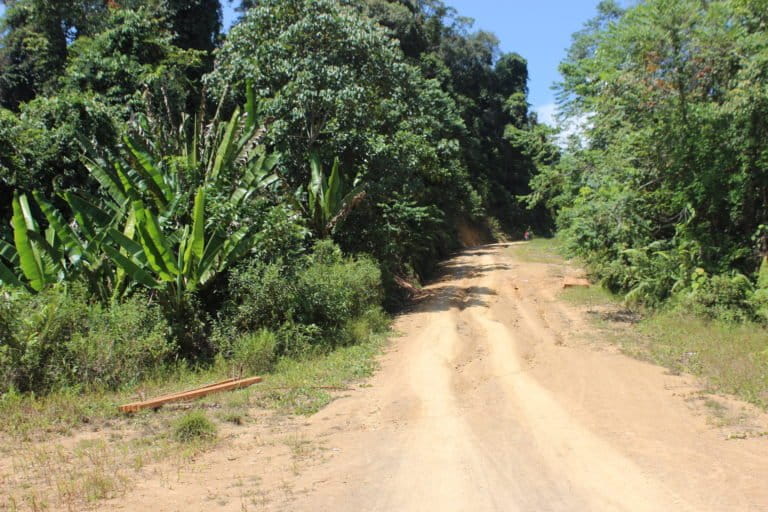
Conservation district
While emphasizing that they’re eager to open up the district for business, local officials also say they’re sensitive to the need to protect the region’s rich natural ecosystem. According to investment board official Kurnia, the district government plans to attract more investment in ecotourism in an effort to boost local economic growth while protecting natural resources.
“In the downstream side of the district, there’s a karst landscape,” she says. “In the upstream, there is more natural landscape that’s stunning. But we do need to catch on infrastructure development for the access to these locations.”
If the district government really aims to achieve economic growth from ecotourism, says Bioma’s Ahmad, then it should refuse to grant permits and allocate concessions for extractive industries like mining or plantations, as these will threaten the very natural riches expected to draw in tourists.
“The road projects must truly be for the people and be based on sustainability principles, not for the corporates which will only seek to exploit for the interests of some,” Ahmad says. “This means there must be effective and valid land planning and management.”
Observers are also calling for the national and local governments to uphold environmental protection. Environmental groups such as Pokja 30, WWF, the Indonesian Forum for the Environment (Walhi), Nurani Perempuan and AMAN have proposed that the national government declare Mahakam Ulu a “conservation district” to protect its environment.
“This initiative must get support from the central government, not just the local government,” Seting says. “Mahakam Ulu is a guardian for East Kalimantan, we shouldn’t let investment come in and destroy it, even though there is road as the gateway for them.”

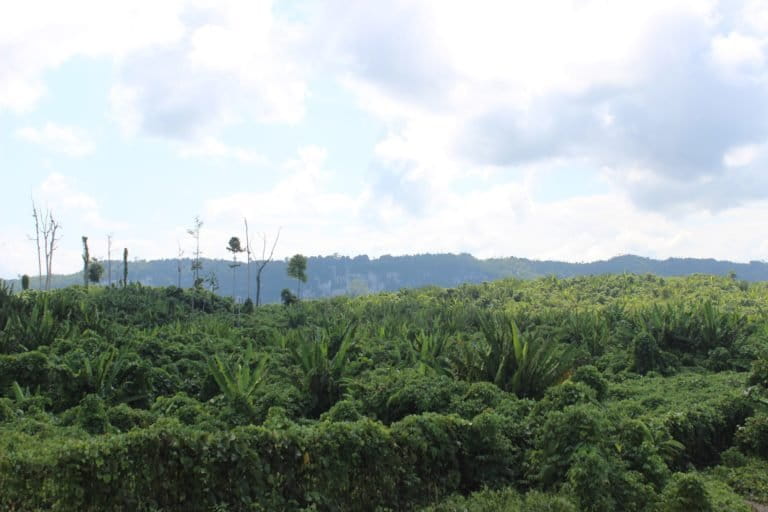
FEEDBACK: Use this form to send a message to the author of this post. If you want to post a public comment, you can do that at the bottom of the page.